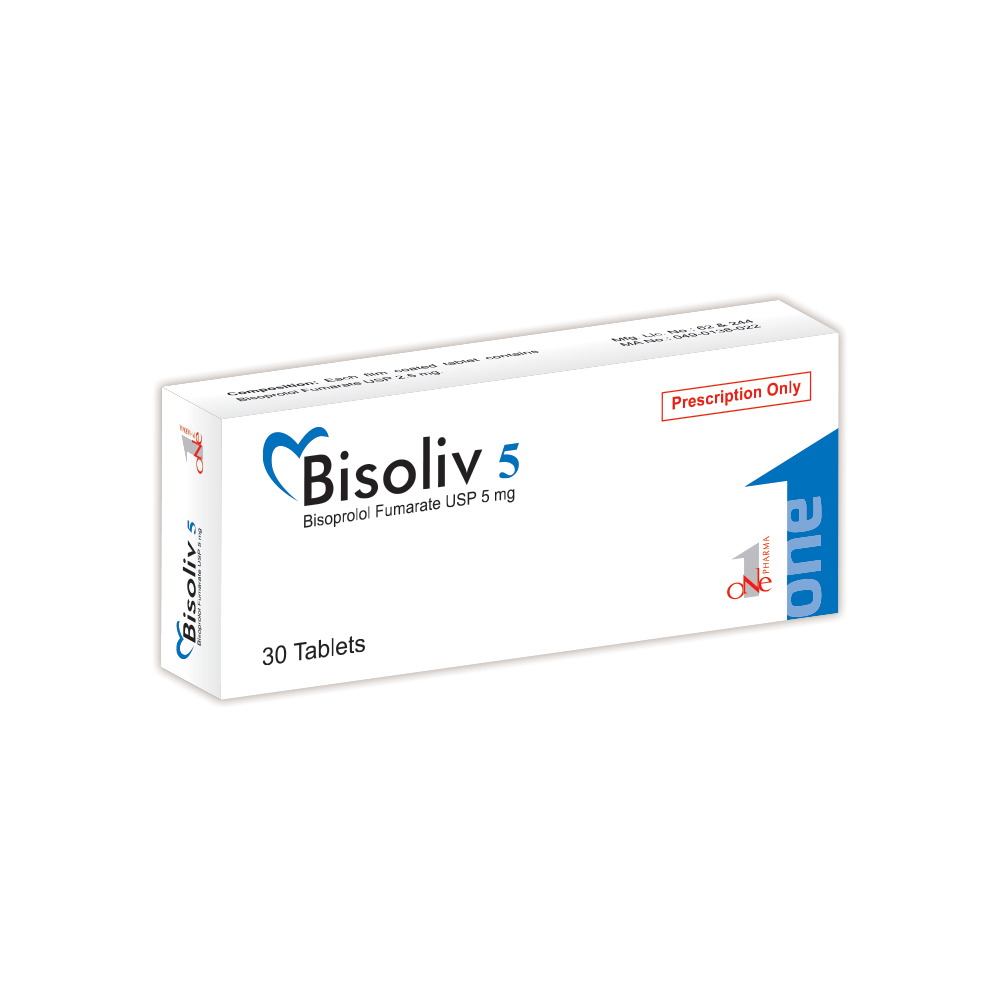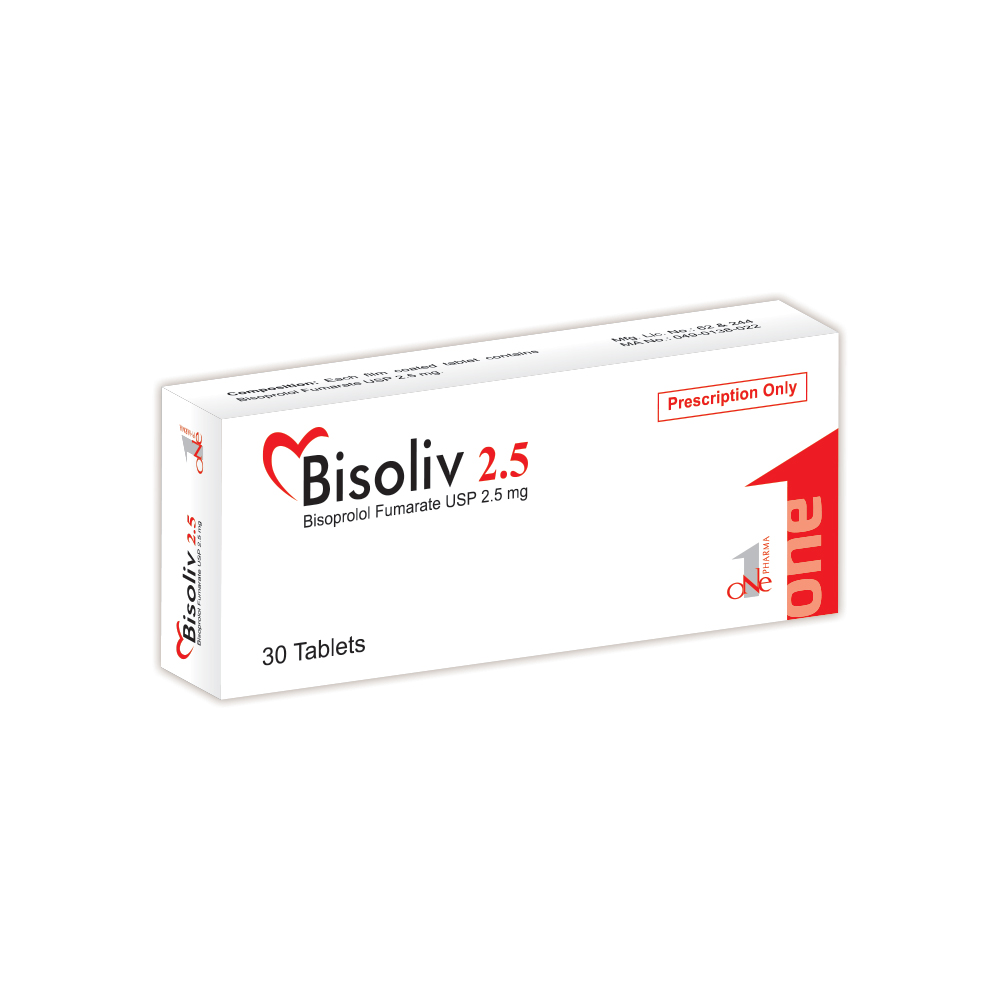





Composition
Bisoliv 2.5 Tablet: Each film coated tablet contains Bisoprolol Fumarate USP equivalent to Bisoprolol 2.5 mg.
Bisoliv 5 Tablet: Each film coated tablet contains Bisoprolol Fumarate USP equivalent to Bisoprolol 5 mg.
Pharmacology
Bisoprolol is a beta1-selective (Cardioselective) adrenoceptor blocking agent without significant
membrane stabilizing activity or intrinsic sympathomimetic activity in its therapeutic dosage range.
Indication
For the treatment of hypertension, angina and heart failure. It may be used alone or in combination with
other antihypertensive agents.
Dose & administration
a) Route of administration: Oral
The dose of Bisoliv must be individualized to the needs of the patient. The usual starting dose is 5 mg
once daily. In some patients, 2.5 mg may be an appropriate starting dose. If the antihypertensive effect
of 5 mg is inadequate, the dose may be increased to 10 mg and then, if necessary, to 20 mg once daily.
Patients with Renal or Hepatic Impairment: In patients with hepatic impairment (hepatitis or cirrhosis) or
renal dysfunction (Creatinine clearance <40 ml/min), the initial daily dose should be 2.5 mg and caution
should be used in dose-titration. Since limited data suggest that Bisoprolol fumarate is not dialyzable,
drug replacement is not necessary in patients undergoing dialysis.
Geriatric Patients: It is not necessary to adjust the dose in the elderly, unless there is also significant
renal or hepatic dysfunction.
Pediatric Patients: There is no pediatric experience with Bisoprolol.
For heart failure: Initially 1.25 mg once daily (in the morning) for 1 week then, if well tolerated, increased
to 2.5 mg once daily for 1 week, then 3.75 mg once daily for 1 week, then 5 mg once daily for 4 weeks,
then 7.5 mg once daily for 4 weeks, then 10 mg once daily; max. 10 mg daily.
Contra-indication
Patients with cardiogenic shock, overt cardiac failure, second or third degree AV block and marked sinus
bradycardia.
Warning and Precaution
Impaired renal or hepatic function.
Side effects
a) Common: Diarrhoea, dizziness, drowsiness, fatigue, headache, lightheadedness, nausea,
sleeplessness, unusual tiredness, weakness, Severe allergic reactions (rash, hives, itching, difficulty
breathing, tightness in the chest, swelling of the mouth, face, lips, or tongue).
b) Rare: Chest pain, difficulty breathing, lightheadedness or dizziness when rising from a lying or sitting
position, very slow heartbeat.
Use in Pregnancy & Lactation
Pregnancy Category C. There are no adequate and well-controlled studies in pregnant women.
Bisoprolol should be used during pregnancy only if the potential benefit justifies the potential risk to the
fetus.
Nursing Mothers: Small amounts of bisoprolol fumarate (< 2% of the dose) have been detected in the
milk of lactating rats. It is not known whether this drug is excreted in human milk. Because many drugs
are excreted in human milk caution should be exercised when bisoprolol fumarate is administered to
nursing women.
Use in Children & Adolescents
See the dose and administration.
Drug interaction
a) With medicine: Bisoprolol should not be combined with other beta-blocking agents. Patients receiving
catecholamine depleting drugs, should be closely monitored, because the added beta-adrenergic
blocking action of Bisoprolol may produce excessive reduction of sympathetic activity. In patients
receiving concurrent therapy with clonidine, if therapy is to be discontinued, it is suggested that
Bisoprolol be discontinued for several days before the withdrawal of clonidine. Bisoprolol should be used
with care when myocardial depressants or inhibitors of AV conduction, such as certain calcium
antagonists or antiarrhythmic agents are used concurrently. Concomitant use with digitalis glycosides
can increase the risk of bradycardia.Concurrent use of rifampin increases the metabolic clearance of
Bisoprolol, resulting in a shortened elimination half-life of Bisoprolol. However, initial dose modification is
generally not necessary.
b) With food & others: Bisoprolol interaction with food–It is important to know how to taka the medication
to avoid the drug-food interaction. This interaction can sometimes also reduce the effectiveness of the
drug itself.
Salt substitute: The combination of Bisoprolol with foods rich in salts like sodium, calcium and
magnesium may reduce or negate the blood pressure-lowering effect of Bisoprolol.
Potassium Rich Food: Bisoprolol may increase the potassium levels in the blood. Avoid taking potassium
rich food with Bisoprolol.
Pleurisy Root: Pleurisy root is not recommended with most heart medication due to the cardiac glycoside
content of the root.
Overdose
The most common signs expected with overdosage of a beta-blocker are bradycardia, hypotension,
congestive heart failure, bronchospasm, and hypoglycemia. To date, a few cases of overdose
(maximum: 2000 mg) with bisoprolol have been reported. Bradycardia and/or hypotension were noted.
Sympathomimetic agents were given in some cases, and all patients recovered. In general, if overdose
occurs, bisoprolol therapy should be stopped and supportive and symptomatic treatment should be
provided. Limited data suggest that bisoprolol fumarate is not dialyzable. Based on the expected
pharmacologic actions and recommendations for other beta-blockers, the following general measures
should be considered when clinically warranted.
Storage
Store below 30° C. Protect from light and moisture. Keep all medicines out of reach of children.
Packing
Bisoliv 2.5 Tablet: Each box contains 30 (3×10’s) tablets in blister pack.
Bisoliv 5 Tablet: Each box contains 30 (3×10’s) tablets in blister pack.